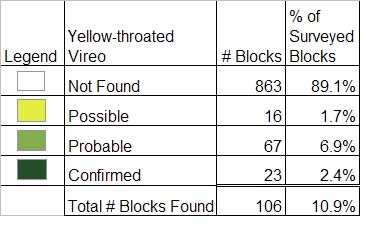Find a Bird - BBA1
Breeding Bird Atlas 1 Species Accounts
Yellow-throated Vireo
Vireo flavifrons
Egg Dates
May 11 to June 17
Number of Broods
one

Although it is the most colorful vireo found in New England, the Yellow-throated Vireo is unknown to most people. Generally uncommon, it summers over a large range in the eastern United States and Canada west to the prairies. In Massachusetts, this vireo was more abundant historically but steadily declined, especially in the eastern counties, in the period 1910 to 1960. While some authors have speculatively tied this decline to the increasing use of pesticides, the actual reasons remain obscure. The dramatic change of the Massachusetts landscape during this period has probably played a role as well. Since 1960, there has been some evidence of population recovery because these vireos have successfully exploited the forest openings created by Beavers.
During the Atlas period, Yellow-throated Vireos were closely associated with Beaver flowages, nesting primarily west of the Connecticut River and extending eastward very locally and sparsely through Worcester County and northern Middlesex County into central Essex County. Nesting is extremely rare in southeastern Massachusetts, with one isolated confirmation from Swansea. Since the Atlas period, there have been additional confirmations from Middlesex and Plymouth counties.
In Massachusetts, Yellow-throated Vireos are summer birds, arriving in the first week of May and departing by mid-September. During most of this period, except for a brief hiatus during molting, males vocalize from the forest canopy, delivering their slurred, two- to three-note phrases, slowly and repetitiously, with rising and falling inflections: eeyay, ayo, oweeah. Many of the call notes are similar to those of the Blue-headed Vireo. There is a low hew call, and excited birds give a chattering chi-chi-cha-cha-chu-chu series.
Yellow-throated Vireos are highly arboreal and are almost exclusively insectivorous, spending most of their time gleaning insects in the canopy of tall trees. They inhabit open deciduous and mixed forest and riparian woodlands, preferring oak and maple, and are often closely tied to wetlands, especially Beaver flowages. They are sometimes encountered, less often than formerly, about the shade trees of villages and farms. Mean territory size is reportedly 10 acres.
The nest, constructed by the female in about a week, is a typical vireo cup suspended from a fork of twigs on a horizontal branch of a hardwood 3 to 60 feet and typically over 20 feet above the ground. Nests in Massachusetts have been located in oak, maple, apple, and other deciduous trees. One nest was built at 20 feet in a Tulip-tree between some forked twigs on a horizontal branch in the middle of the tree. Others were found in overgrown orchards (ACB). Two recent nests from the Prescott Peninsula in Quabbin were located as follows: 1 at 25 feet in a deciduous tree, 5 feet from the end of a branch over a field; 1 at 15 feet in a Red Maple, 3 feet from the end of a horizontal branch (Small). A post-Atlas nest in Halifax was built at 20 feet in a Red Maple (Petersen). Bark, lichen, and moss are interwoven with caterpillar silk and spider webs to create a beautiful three-inch in diameter nest. The inside is lined with fine grasses and pine needles.
Clutches of three to five (typically four) eggs are laid. Clutch sizes for three Massachusetts nests were two eggs, possibly incomplete (one nest); four eggs (two nests). Eggs are dull white with brown dots concentrated toward the large end. Incubation, shared by both sexes, lasts about 14 days. Incubating birds reportedly sit very tightly on the nest, and males sometimes sing while on duty. Young fledge in about 15 days. Data for nesting in Massachu- setts is very scanty. A brood of three young fledged from a nest in Wayland from June 15 to June 17 (Tewksbury). In Worcester County, an adult and one large fledgling were observed on July 6 (Meservey).
Individuals that have completed molting do not flock together, but single birds may join feeding flocks of chickadees, warblers, and other birds. These vireos have left Massachusetts by the end of September and are en route to their winter quarters, which include most of Mexico south to Panama, Cuba, Isle of Pines, the Bahamas, and casually to northwestern South America.
Map Legend and Data Summary
Atlas 1 data collected from 1975-1979


Note: uncommon and local in deciduous woodlands near water; occasionally in roadside shade trees
Thomas F. Tyning



